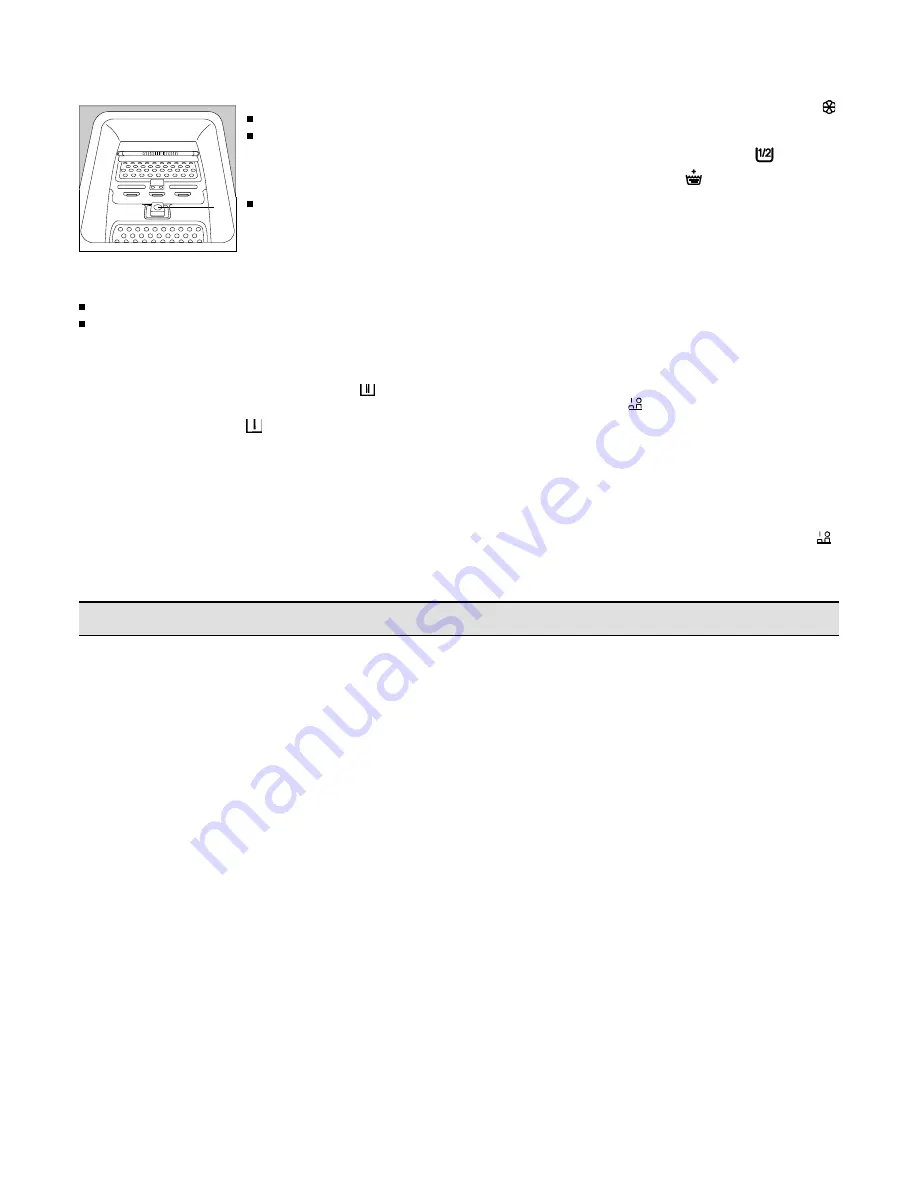
- 5 -
A
Operating instructions
1. Place the laundry in the drum
Lift up the lid of the machine.
Open the drum with your two
hands by pressing the button A
and the two flapdoors till they
disengage.
Introduce the laundry into the
drum ; close the drum and the lid
of the machine.
Be careful : before closing the lid of your machine, make sure
that the drum flapdoors are correctly closed :
the two flapdoors fastened,
the button A pressed out.
2. Measure out the detergent
Measure out the amount of detergent recommended by the
manufacturer in the main wash compartment (
).
If you wish to carry out a prewash, pour the amount required into
the prewash compartment (
).
Do not exceed the MAX level.
3. Add the bleach agent
You may use a bleach agent on cotton programmes. However,
make sure that the fabric withstands the treatment.
Make sure that the level of the liquid never exceeds the
MAX level.
4. Add the fabric softener
Pour the softener, if required, into the compartment marked .
Do not exceed the MAX level.
5. Press the half load pushbutton "
" or/and
the rinse plus pushbutton
"
"
if required.
6. Select the temperature
Choose the temperature which corresponds to the chosen
programme on the basis of the type of laundry and the fastness
of the colours.
7. Select the programme
Choose the programme according to the nature and the degree
of soil of the laundry. Turn the programme selector clockwise
to select the chosen programme.
8. Starting of the programme
The ON/OFF pushbutton
"
"
enables to switch your machine
on:
the control lamp illuminates and the programme starts.
9. At the end of the programme
When the selected programme is over, the machine stops
automatically. The timer knob stops on the position
"I"
for all
the programmes and the control lamp extinguishes.
After each wash, depress the ON/OFF pushbutton "
".
Press off the other pushbuttons if necessary ; unplug the
machine from the wall socket ; turn off the water tap. Leave the
drum and the lid open in order to air the washing machine.
You are advised not to leave your laundry too long, especially
when damp. Damp laundry produces moult and unpleasant
smells.
Moult stains cannot be removed.
Sort your laundry.
Study carefully the chart in this booklet explaining the symbols
used on clothes labels (see page 6).
The following points are particularly important :
- a line under the bowl means that the garment cannot be
washed using programmes for resistant fabrics such as
cotton and linen;
- do not mix coloured garments with whites;
- anticrease materials like polyester/cotton should be treated
as synthetics;
- non-resistant fabrics like acrylic and most curtain materials
should be treated as delicate fabrics;
- the wool programme is designed specifically for pure new
wool. Other types of wool and wool mixtures may shrink or felt
if machine-washed.
Woollen garments should be spun briefly immediately after
washing.
Prewash
Prewash is not normally necessary. Your new washing ma-
chine combined with modern detergents will give perfect
washing results without prewash, thus saving energy, time,
water and detergent.
However, when the laundry is particularly dirty (for instance if
you have to wash mechanics' overalls or butchers' aprons),
you are advised to use prewash with a biological detergent.
HINTS AND TIPS
Temperatures
We suggest that white cotton and linen, if it is not excessively
soiled, can be washed at 60° instead of 90°C. There should be
no reduction in performance, but there will be an energy saving
of approximately 30%.
The same applies to a lesser extent to fast coloured garments.
They usually require a temperature of 60°C but if they are not
excessively dirty, you will have satisfactory results at 40°C.
Garments with non-fast colours should not be washed at
temperatures above 40°C. If fast and non-fast colours are
washed together, they should be treated as non-fast colours
and therefore the temperature should not exceed 40°C.
Resistant white and coloured synthetics can normally be
washed at 60°C but also in this case 40°C is sufficient if the
laundry is not excessively dirty.
Delicate synthetics, synthetics with non-fast colours and
woollen garments must never be washed above 40°C.
As you already know, your washing machine can also wash
with cold water. However, it must be remembered that the
detergents currently on the market have not been designed for
cold washes and that in winter, when the water is very cold,
they may not dissolve adequately.
We suggest the use of liquid detergents.
How much laundry can be washed in one load?
Strictly speaking you should always weigh your laundry.
The drum will take a maximum of 5 kg of cotton and linen. For
synthetics and delicate fabrics, the maximum load is 2,5 kg
and for wool, 1 kg.


























